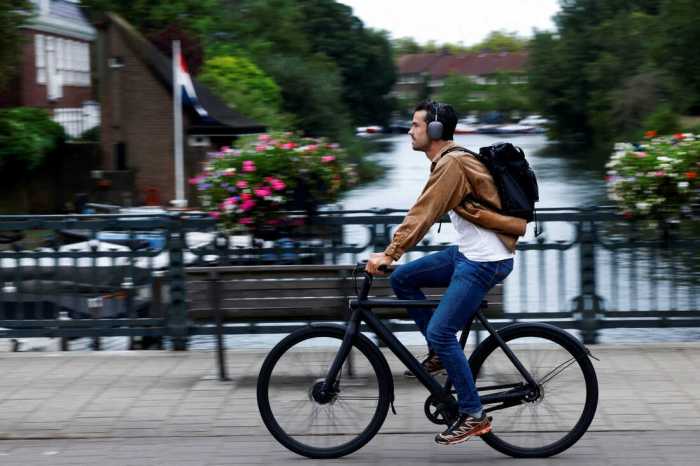Ebike VanMoof bankrupt. The news sent shockwaves through the cycling world, leaving many wondering how a company known for its sleek designs and innovative technology could crumble so quickly. VanMoof’s rise to fame was fueled by a direct-to-consumer approach, focusing on premium e-bikes that promised a stylish and convenient way to navigate urban landscapes.
Their bikes, with their integrated technology and sleek aesthetics, quickly gained a loyal following, and VanMoof seemed poised for continued success.
However, behind the sleek facade, challenges began to emerge. Rising costs, supply chain disruptions, and increasing competition put pressure on VanMoof’s bottom line. The company’s rapid growth, while impressive, also brought with it its own set of difficulties, including managing a complex global supply chain and adapting to evolving consumer demands.
The COVID-19 pandemic further exacerbated these issues, disrupting production and creating financial strain. Ultimately, these factors led to VanMoof’s bankruptcy, leaving behind a trail of questions about the future of the e-bike industry and the lessons to be learned from its downfall.
VanMoof’s Business Model and Growth
VanMoof, the Dutch e-bike company, captured the attention of urban cyclists worldwide with its sleek designs, innovative features, and direct-to-consumer approach. The company’s rapid growth in recent years was fueled by a combination of factors, including its unique business model, clever marketing strategies, and a strong focus on product development.
VanMoof’s Business Model
VanMoof’s business model revolved around a direct-to-consumer (D2C) approach, eliminating traditional retail markups and offering a streamlined customer experience. This model allowed the company to maintain competitive pricing while focusing on high-quality products and customer service.
- Premium E-bikes:VanMoof’s e-bikes were positioned as premium products, targeting a market segment willing to pay a premium for sleek design, innovative features, and a user-friendly experience.
- Direct-to-Consumer Sales:VanMoof bypassed traditional retail channels, selling its bikes directly to customers through its website and physical brand stores. This allowed the company to control the entire customer journey, from product design to after-sales support.
- Subscription Model:VanMoof introduced a subscription model called “VanMoof Membership,” offering customers access to various benefits, including theft protection, repairs, and maintenance. This subscription model generated recurring revenue and further solidified customer loyalty.
Factors Contributing to VanMoof’s Growth
Several factors contributed to VanMoof’s rapid growth, including:
- Innovative Designs:VanMoof’s e-bikes were known for their sleek and minimalist designs, often featuring integrated lights, fenders, and other features that made them stand out from traditional bicycles.
- Focus on User Experience:VanMoof prioritized a user-friendly experience, incorporating features such as automatic gear shifting, integrated GPS tracking, and smartphone connectivity.
- Effective Marketing Strategies:VanMoof utilized a mix of digital marketing, social media, and influencer collaborations to reach a wider audience and build brand awareness.
- Strong Brand Identity:VanMoof cultivated a strong brand identity, associating its products with urban mobility, sustainability, and a stylish lifestyle.
VanMoof’s Timeline of Key Milestones
VanMoof’s journey was marked by several key milestones:
- 2009:Founded by Taco Carlier and Ties Carlier in Amsterdam.
- 2010:Launched its first e-bike, the VanMoof S.
- 2013:Introduced the VanMoof Electrified S, its first commercially successful e-bike model.
- 2016:Opened its first brand store in Amsterdam.
- 2018:Launched the VanMoof S3 and X3 models, featuring a redesigned frame and improved features.
- 2019:Secured $122 million in funding, led by Goldman Sachs.
- 2020:Expanded its global footprint with new brand stores in cities like New York, London, and Paris.
- 2021:Introduced the VanMoof S5 and X5 models, incorporating new features such as automatic gear shifting and integrated GPS tracking.
- 2022:Filed for bankruptcy.
Challenges and Financial Difficulties
VanMoof’s meteoric rise in the e-bike market was not without its challenges. The company faced a confluence of factors that ultimately contributed to its financial struggles and eventual bankruptcy. These challenges included increased competition, supply chain disruptions, rising costs, and the impact of the COVID-19 pandemic.
Increased Competition
The e-bike market has become increasingly competitive in recent years, with numerous established and emerging brands vying for market share. VanMoof faced stiff competition from established players like Trek, Specialized, and Giant, as well as from newer entrants like Cowboy and Rad Power Bikes.
This intense competition put pressure on VanMoof to maintain its pricing and product innovation, making it challenging to sustain its growth trajectory.
Supply Chain Disruptions
Like many businesses, VanMoof was impacted by global supply chain disruptions, particularly in the wake of the COVID-19 pandemic. These disruptions led to delays in the production and delivery of components, causing production bottlenecks and impacting VanMoof’s ability to meet demand.
The company also faced challenges sourcing key components, including batteries and motors, due to increased demand and limited supply.
Rising Costs
VanMoof faced rising costs for materials, labor, and shipping, which put pressure on its profit margins. The company’s reliance on high-quality components and its direct-to-consumer sales model contributed to its higher costs compared to some competitors. The rising costs made it increasingly difficult for VanMoof to maintain its pricing while remaining profitable.
Finish your research with information from peugoet e bike cargo cycling europe.
Financial Difficulties
The challenges Artikeld above contributed to VanMoof’s financial difficulties. The company’s mounting debts, declining sales, and investor concerns ultimately led to its bankruptcy.
Mounting Debts
VanMoof’s rapid growth was fueled by significant investments, leading to a substantial debt burden. The company’s high operating costs, including research and development, marketing, and customer service, further exacerbated its debt situation. The inability to meet its debt obligations became a significant financial challenge.
Declining Sales
Despite its early success, VanMoof experienced declining sales in recent years. Factors contributing to this decline included increased competition, supply chain disruptions, and a challenging economic environment. The company’s high prices and its reliance on a direct-to-consumer sales model also contributed to the sales slowdown.
Investor Concerns
VanMoof’s financial performance and its ability to achieve profitability raised concerns among investors. The company’s mounting debt and declining sales led to a loss of investor confidence, making it difficult to secure further funding. This lack of investor support further hampered VanMoof’s ability to navigate its financial challenges.
Impact of COVID-19 Pandemic
The COVID-19 pandemic had a significant impact on VanMoof’s business operations and financial performance. The pandemic disrupted global supply chains, leading to delays in production and delivery. It also resulted in a decline in demand for e-bikes as consumers reduced their spending and mobility options were restricted.
The pandemic exacerbated VanMoof’s existing financial challenges, contributing to its eventual bankruptcy.
Impact of Bankruptcy on the E-Bike Industry
VanMoof’s bankruptcy sends shockwaves through the e-bike industry, raising questions about the sector’s future and the implications for both consumers and businesses. While VanMoof’s specific challenges were unique, its demise highlights potential vulnerabilities within the broader e-bike market.
Impact on Consumer Confidence
The bankruptcy of a prominent brand like VanMoof can erode consumer confidence in the e-bike industry. Consumers may be hesitant to invest in e-bikes if they perceive the market as unstable or unreliable. This could lead to a decline in e-bike sales, especially for newer brands that are still building trust and reputation.
Potential for Consolidation and Restructuring, Ebike vanmoof bankrupt
VanMoof’s bankruptcy could trigger a wave of consolidation or restructuring within the e-bike industry. Smaller players might struggle to compete with larger, more established brands, leading to mergers or acquisitions. This consolidation could create a more concentrated market with fewer players, potentially impacting innovation and competition.
Future of VanMoof and Its Assets

The bankruptcy of VanMoof has left many wondering about the fate of the company’s assets and intellectual property. While the immediate future is uncertain, several potential scenarios could unfold, each with its own implications for the e-bike industry and VanMoof’s loyal customer base.
Potential Scenarios for VanMoof’s Assets
The fate of VanMoof’s assets will depend on the outcome of the bankruptcy proceedings. Several potential scenarios could unfold, each with its own implications for the company’s future.
- Sale of Assets:A common outcome in bankruptcy is the sale of a company’s assets to another entity. In this case, a potential buyer could acquire VanMoof’s intellectual property, including its designs, patents, and brand name, as well as its manufacturing facilities and equipment.
This scenario could allow VanMoof’s technology and brand to continue, potentially under new ownership.
- Liquidation:In a liquidation scenario, VanMoof’s assets would be sold off piecemeal, with the proceeds distributed to creditors. This would likely result in the dismantling of the company and the loss of its brand and intellectual property. This scenario would be the least favorable for customers, as it would likely lead to a discontinuation of support for existing bikes and a lack of future products.
- Restructuring:Another possibility is that VanMoof could restructure its operations and emerge from bankruptcy as a smaller, more focused company. This scenario would likely involve significant changes to the company’s business model and a reduction in its workforce. However, it could also provide an opportunity for VanMoof to address its past challenges and return to profitability.
Lessons Learned from VanMoof’s Bankruptcy: Ebike Vanmoof Bankrupt

The collapse of VanMoof, a once-promising e-bike company, serves as a stark reminder of the perils of rapid growth, unchecked spending, and a lack of adaptability in the face of market shifts. While VanMoof’s story is unique, it offers valuable lessons for other e-bike companies seeking to navigate the competitive landscape.
The Importance of Sustainable Growth
VanMoof’s aggressive expansion strategy, fueled by venture capital, led to rapid growth but also created unsustainable financial pressures. The company prioritized market share over profitability, expanding its operations too quickly without adequately managing its costs.
- E-bike companies should prioritize sustainable growth by carefully balancing expansion with profitability.
- They need to ensure they have the resources and infrastructure in place to support their growth trajectory.
- Focusing on organic growth and profitability over rapid expansion is crucial for long-term success.
The Need for Cost Control
VanMoof’s high-end e-bikes, while innovative, came with a high price tag. The company’s direct-to-consumer model, while eliminating retail markups, also meant that it had to bear the entire cost of production, distribution, and customer service.
- E-bike companies must closely manage their costs to maintain profitability, especially in a competitive market.
- This includes streamlining operations, optimizing supply chains, and finding cost-effective ways to deliver products and services.
- Exploring alternative distribution models, such as partnerships with retailers, can also help reduce costs.
Adapting to Market Changes
VanMoof’s business model, focused on high-end e-bikes with limited customization options, struggled to adapt to the evolving e-bike market. Consumers increasingly sought more affordable and customizable options, leading to a decline in VanMoof’s sales.
- E-bike companies need to be flexible and responsive to changing market demands.
- This includes diversifying product offerings, exploring new price points, and adapting to evolving consumer preferences.
- Regular market research and competitor analysis are essential to stay ahead of the curve.
Challenges of a Direct-to-Consumer Model
VanMoof’s direct-to-consumer model, while offering advantages like control over branding and customer experience, also presented challenges. The company struggled to manage customer service issues efficiently, particularly with its complex repair process.
- E-bike companies employing a direct-to-consumer model need to invest heavily in customer service infrastructure.
- This includes establishing robust customer support channels, providing clear and accessible repair procedures, and building a loyal customer base.
- Building a strong online presence and fostering a sense of community can also be crucial for success.





